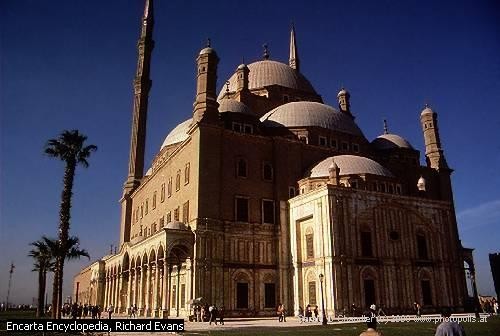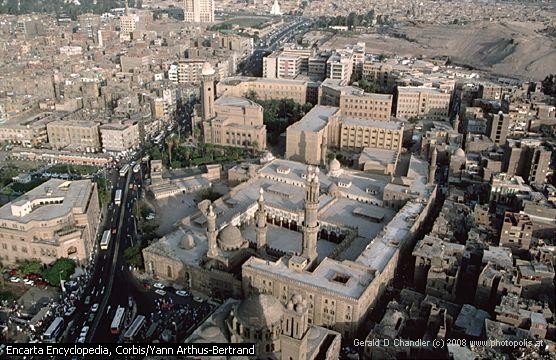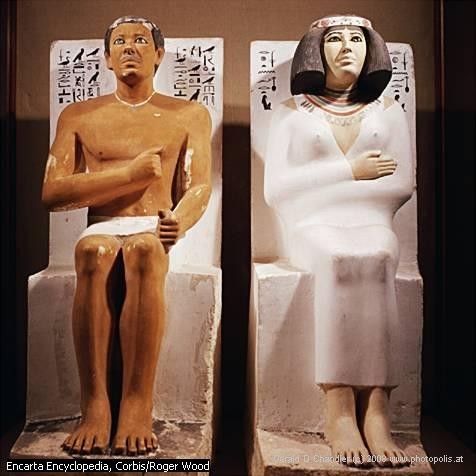Home | Front Page | Blog | Index | New | Contact | Site Map
Sharm El Sheikh
Ras Snorkeling
Upper Egypt
Nile Cruise
Cairo
Egypt Security
Israel Bus & Border
Foto Show

Egypt
Israel
Turkey
Bulgaria
Romania
Ukraine
Poland
Prague
Britain
USA 2002
Travel Map
As dawn broke we approached Cairo from the south on our overnight train from Luxor (about 650 km). We'd been unwilling to pay the high price for a sleeper so had dozed all night long. We knew the city a bit from a previous, 1985 visit of about a week. That time we had stayed in the Victoria Hotel, about 1/3 of the way from the train station to what is the center of the city for us: the Egyptian Museum - Tahir Square area. Now, pleasant memories in mind, we wanted to go back. In the early morning cool we roused ourselves from our poor sleep, left train and station, passed the giant statue of Ramses for which the station is named, and took a taxi to the Victoria Hotel.
In our first visit we had discovered the Victoria after a long morning's search: On October 9, 1985 we arrived at 4:00 from an overnight from Singapore (just as the Achille Lauro incident was ending, we would learn) and let ourselves be persuaded by a tout to take us in his taxi to a "good" hotel. The place, in the Abdin area, was so run down that the room had a hole in the wall and the plumbing was a disaster. After four hours sleep we got up and used our guide book to find and visit about ten hotels. In our price range the Victoria stood out as a wonderful value.
Seventeen years later Cairo and the Victoria had changed, the first for the better and worse and the second, even if only temporarily, for the worse. The Victoria's pleasant atmosphere was spoiled by the soils of a reconstruction or repair project that we found ourselves in the midst of. Still, the room was comfortable and well located. And, if memory serves, the price in dollars had hardly changed.
The Citadel
Our first visit lasted a week and we saw things we would not attempt to visit again this time: In 1985 we'd broken our usual rule to take a taxi-tour to Giza and the pyramids, we'd gone to the giant cemetery called the City of the dead, seen Heliopolis and the parade grounds where Anwar Sadat was killed in 1981, had visited the center of "modern", upper class Cairo, Zamalik/Jazirah, a large island in the Nile, and walked all about the Citadel and visited most of its famous mosques.
This time we limited our stay to three days. We decided to repeat and extend our visits to to Bab-Al-Khalq area (or Islamic Cairo), the site of several large mosques, the biggest Souk in the City and the Al-Azhar University; to Old Cairo, the home of the Coptic Museum and the Ben Ezra Synagogue; and to the wonderful, incomparable Egyptian Museum. Each day we went back in time a millenium or even two.
Perhaps memory is playing a trick but when we left we felt we knew the city better than after the 1985 stay. Perhaps it is not playing a trick and the reason we know it better is that we walked more: we walked from the Victoria Hotel to Bab-Al-Khalq (under 3 km) and from the Victoria to the Cairo Museum (about 2 km).
Bab-Al-Khalq — Islamic Cairo
As with any large city one does not have to go far to see a change in neighborhood or experience another version of history. If Zamalik represents modernity and laicism, Islamic Cairo, represents the home to Islamists and the traditions they attempt to maintain or revive.
The coming of the railroad created a new district around Ramses station and a new boulevard connecting it to Tahrir Square and a place for the Victoria Hotel. On our second day in Cairo we set out to walk to Islamic Cairo, our route taking us around the northern side of nearby Ezbekiya Gardens and Square and directly into the heart of "populous" Cairo. We were immediately among spice and cloth shops and sidewalks so crowded to overflowing with vendors that the pedestrians more than overflowed into the streets, and at least for the smaller ones, nearly appropriated them.
We went as best as we could toward and then down Shari al-Azhar boulevard. Because the distances are small it was only a half an hour or so before we found ourselves near Ghazili?? Mosque and Madrassi, the center of what we would see that day. We sat down on a curb to just watch the world pass by, intrigued by people who were recognizably similar in dress and bearing but who emanated differences.
We had not been there long when a young man, maybe 25, approached us. We're happy and wary in such circumstances: what does he want? He spoke reasonable English and quickly told us: he was a medical student, wanted to meet foreigners, and wanted to practice English. He invited us to come take tea with him, and with a glance at each other that meant "dare we?" we agreed and followed him into "the souk". Not perhaps as mysterious as in movies, the path was tortuous and the lanes narrow. Could we find our way back? Could we be heading to a kidnapping? (Coming through Tahrir Square one night we had been approached by another young man who started a conversation. He'd invited us to his home for tea. We'd cautiously declined.)
We ended up at a small tea/soda stall of the medical student's choosing. It was not bigger than many of our hotel rooms, perhaps 15 feet by 7, with an atmosphere more of a tent than a shop since the front and large parts of the walls were covered with pieces of canvas. We bought him and ourselves sodas and we talked about his life as a student. He was disdainful of islamists.
Afterwards we walked around the area, full of buildings dating from the 11th and 12th centuries. We saw the decorated outsides of many mosques and old homes, with their ruined wooden balconies. At one mosque undergoing reconstruction and thus closed the guard spied a chance to put some coins his pocket: seeing us on the street he invited us in, and true to his hopes, when we left some money stayed with him.
Once there was a great wall that encircled the city — that is, inner Cairo, and it had eight gates, or Babs. We walked around and saw what there was of the three gates that remain: Bab Zuwaylah, Bab al Nasr, and Bab al Futuh, the last being close to the mosque where we had our invited tour.
In the same general area is the Al-Azhar University and the mosque out of which it grew. It is set back from the modern boulevard by a large plaza that swarmed with students when we were there. We walked close enough to where we could see a bit into the mosque courtyard but were too timid to go in or even stop someone and ask if we could go in.
Instead we went a few blocks away to another great mosque, the mosque of the great Khan al Khalili market. It was bubbling with activity and very open for people to go in. After enjoying its beauty we wandered through the market some. By then it was late in the day and we made our way on foot back to the Victoria, getting a bit lost, but seeing lots more street life.
Misr al-Qadimah or Babylon
Old Cairo, also known as Misr al-Atiqah or Misr al-Qadimah or Babylon-in-Egypt, existed even before there was a Cairo. Of course the general Cairo area has a history stretching back 6,000 years. But Cairo (Arabic Al-Qahirah or "The Victorious"), or pre-megalopolis Cairo, was founded around 900 A. D. a bit north of Al-Fustat, a military encampment established in 641 for the siege of nearby Babylon. Babylon, a baby compared to 5,000 year old Memphis, home of very early pyramids, was the Roman version of "Victory City", established as a fort 2,000 years ago when Romans were grabbing all of the eastern Mediterranean.
Our selected means for going to Old Cairo was the new-to-us Metro system. Coming in on the train from Luxor we'd passed — even stopped — in the station shared by railway and metro that serves the Coptic district. In 1985 we saw much evidence of the construction of the subway or Metro system. It opened in 1987 and has made life much more comfortable for those who can afford it. We were anxious to see it and found it sleek, modern, and clean. From our guide book we knew that in this Arab-Muslim society that of each 4-5 car train the last car or two were reserved for women and so were careful to get on the right car. But we'd misunderstood the rules which allow men in some of the reserved cars at rush hour. A very polite young lady indicated to us that Gerry, beard or no, was out of place. So at the first stop we moved from the last car to the second to last. Whoops! After we were moving it again became apparent that this was an females-only car.
Arriving at the Misr station we were only a few steps from where we wanted to be. Just outside the station we found excavation work going on to restore the old Roman fort. One day it will be a star attraction of Cairo.
Just beyond was the Coptic Museum. Its main, or at least historical building was getting a work-over, including a new stone patio in front. We spent a few minutes watching a very skilled workman cut curb stones from raw granite using the most primative of tools, a sort of axe and hammer. The work-over is good for the museum but bad for us — major areas were closed. But what there was to see was wonderful. So many beautiful pre-Islamic icons, textiles, and stones; wooden doors with magnificent carvings; ancient swords and shields; and on and on. We spent a very pleasant half day there.
Nearby, just a few minutes walk, are three other sites that we visited in the rest of the day. We made a repeat visit to the Ben Ezra synagogue, the oldest in Cairo, and one of the oldest in the world. We'd seen it in 1985, pre-restoration. Now is better and then was better: an atmosphere and patina of age is gone, replaced by a shine of beauty and value. We made our first visit to the imposing Al Mu'allaqa Coptic church that sits on a little hill above Roman fort and Coptic museum. The site, but not the current church, is thought to be where Christian worship started in Egypt in the third century. On the short street connecting all of these are several large shops, very tourist oriented. We went into one and loved several pieces, especially an inlaid desk with a chess board on top. If only we had a home for them!
Egyptian Museum
There is simply nothing to compare with the Egyptian Museum. Egypt has five or six thousand years of history and in its two floors there are thousands, perhaps hundreds of thousands of items on display. Just from the tomb of Tutankhamun there are 1,700 pieces. Early one day we walked from the Victoria Hotel through the law and court district toward the museum. We slowed ourselves a bit to look at the law books for sale, laid out on cloths on the side walk. And then we were slowed by the major highway that passes the Museum; it is too broad and has too many cars to cross safely but we did manage it.
Once at the museum we had to undergo double security check: first at the outer gate we had an airport-style check before we bought our tickets. And then, ticket in hand, we had the first check duplicated at the main door. (We went through this twice because we went out for lunch and came back in.) We'd visited in 1985 and were overawed. It happened again. This time Gerry had a digital camera and took many photos (which don't appear here because this was written "on the road", far from the photo-bearing CD). We think the Tutankhamun displays have been re-organized. Or maybe parts were closed on our first visit. But this time they were all open, there were almost no crowds, and we saw all the magnificence.
Achille Lauro, Italian cruise ship hijacked off the Mediterranean coast of Egypt on October 7, 1985, by members of the Palestinian Liberation Front (PLF), a small guerrilla faction of the Palestine Liberation Organization, demanding the release of Palestinian prisoners in Israel. Two days later, the hijackers were induced to surrender by Egyptian President Hosni Mubarak and PLF leader Mohammed Abbas. More than 400 passengers and crew of the Achille Lauro were released, but the hijackers had shot to death and thrown overboard an invalid Jewish American passenger, 69-year-old Leon Klinghoffer. Mubarak permitted Abbas and the hijackers to fly to PLF headquarters in Tunisia aboard an Egyptian commercial airliner. However, United States President Ronald Reagan sent U.S. Navy jet fighters to intercept the flight and, with the consent of Italy's Premier Bettino Craxi, to force the aircraft to land at the joint U.S.-Italian air base at Sigonella, Sicily.
The United States and Italy contested jurisdiction in the case. When the Craxi government allowed the Egyptian plane to fly to Rome, U.S. officials requested that Abbas be held in Italy for extradition in view of evidence that he had engineered the hijacking. However, Craxi allowed Abbas to go to Yugoslavia. An Italian court convicted 11 of the 15 men charged with involvement in the cruise ship hijacking. Abbas and two of his associates, one of whom was captured in 1991, were tried in absentia and found guilty of organizing the hijacking. The jury sentenced them to life imprisonment. All four of the Palestinian hijackers who carried out the hijacking were given sentences ranging from 15 to 30 years. The ringleader of the hijackers, Magied Youssef al-Molqi, was given 30 years. More than 17 years after the Achille Lauro hijacking, U.S. forces captured Abbas near Baghdad during the 2003 U.S.-led invasion of Iraq. The incident weakened the Italian coalition government, strained U.S.-Italian and U.S.-Egyptian relations, and slowed Arab-Israeli peace efforts.
© 1993-2003 Microsoft Corporation. All rights reserved.




